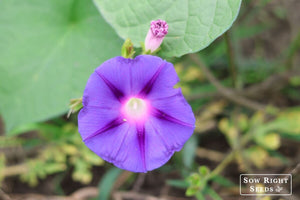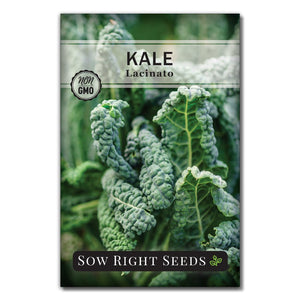How to Grow the Sweetest Spinach Leaves You'll Ever Taste
Leafy greensSpinach has been cultivated for centuries and, at times, has had great popularity as a superfood. We know we’re more than a little biased, but homegrown spinach always tastes better than anything you’ll buy at a store. Spinach is easy to grow and can be the best part of your vegetable garden. We’ll show you how to grow and enjoy heirloom spinach.

How to Grow Spinach From Seed
Spinach is easy to grow from seed. It does best in temperatures between 50-70ºF, which makes it an excellent crop for a fall garden. It can also be your first harvest in a spring garden. Also, spinach is the perfect winter crop in growing zones with mild winters.
Spinach seeds can be sown outdoors or indoors about six weeks before the last frost date.
For a continuous harvest, you can plant seeds every ten days until temperatures rise above 70ºF.
Sow spinach seeds directly outside in nutrient-rich soil.
Plant seeds ½” deep and keep the seeds moist.
Spinach seeds will germinate in 7-14 days.
When seedlings are small, thin spinach plants to 6” apart.
If starting seeds indoors, use grow lights to give adequate light for growth.

How to transplant spinach seedlings
Spinach seeds can be started indoors and transplanted to the garden.
Once seedlings are several inches tall and have at least three true leaves (about 5 weeks), you can start hardening them off.
Take care when removing seedlings from pots to minimize disturbing the roots.
Space spinach seedlings 6” apart.
How to Grow Spinach Plants
Soil:
Spinach thrives in well-draining, nutrient-rich soil. Add well-rotted compost before planting spinach seeds. A neutral soil pH between 6.0 and 7.0 is ideal. Raised beds are excellent for growing spinach.
Sunlight:
Spinach loves cool weather and thrives in partial shade to full sun. In warmer climates, partial shade, specifically afternoon shade, will help to prevent bolting (premature flowering). Once spinach goes to seed, it will stop growing fresh leaves, and its flavor becomes less sweet.
Watering:
Keep the soil consistently moist by watering regularly, especially during dry spells. Water at the base of the plant to prevent fungal diseases. Keep soil moist but not waterlogged to avoid root rot. Not enough water will result in stress to the plant and less growth.
Fertilizing:
Spinach leaves taste better when they grow fast without stress. A nitrogen-based fertilizer will encourage leaf growth. Fertilizer can be applied four weeks after planting or transplanting.
Mulching:
Keeping the weeds down will allow the spinach plants to grow without competition. Using much can help to keep the soil moist and cool while controlling weeds.
Heirloom Spinach Varieties
Bloomsdale
Bloomsdale Spinach is a popular heirloom variety from 1874. It has an outstanding flavor and deep green, savoyed leaves. Bloomsdale spinach is cold-hardy and slightly more heat tolerant than other spinach varieties.
Viroflay
Viroflay Spinach is a tried and true heirloom variety grown in the US since 1866. Huge spade-shaped leaves grow quickly and reach up to 10" long. Very cold-hardy, Viroflay spinach is a perfect crop for winter.
Solutions for spinach pests and diseases
Aphids can be the most common pest on spinach plants. Use neem oil and other natural methods to get rid of them.
Slugs and snails like the cool, moist conditions for growing spinach. Use traps and pick them off before they can do too much damage.
Damping off and mildew can be problems when growing conditions are too wet. Use effective watering methods to avoid over-watering spinach.
Harvesting Spinach
For the sweetest spinach harvest, start harvesting the leaves as soon as they are big enough to use. Smaller leaves are referred to as baby spinach and are more tender and sweet. The larger they grow the less tender they'll be.
Cut the outer spinach leaves first, leaving the center intact for continued growth. Harvesting in the morning is best for flavor and freshness.
Once harvested, spinach doesn’t keep for long. That’s why growing your own is the best. You’ll be able to pick fresh spinach leaves at the height of their taste and nutrition and enjoy them right away.
To store fresh garden spinach, loosely wrap it in paper towels and place it in a plastic bag or container. Wait to wash the leaves until you are ready to use them. Spinach will keep for up to a week in the refrigerator.

Tips on Cooking and Eating Spinach
The healthiest and tastiest way to cook spinach is a quick boil. Once the water is boiling, add the fresh spinach and cook for 1 minute. It will still be bright green. When spinach is no longer bright green, it has lost a significant amount of nutrients and will be mushy. If adding spinach to soups and sauces, add it in the last minute of cooking.
Adding fresh spinach to salads and sandwiches will give a boost of flavor and nutrition.
Health Benefits of Fresh Spinach
Apart from being a delicious addition to your meals, fresh spinach offers a myriad of health benefits:
Rich in Nutrients: Spinach is packed with essential vitamins and minerals, including vitamin A, vitamin K, iron, and calcium, which are crucial for bone health and overall well-being.
Full of Antioxidants: It contains antioxidants like lutein and zeaxanthin, which are known to promote eye health and protect against age-related macular degeneration.
Low in Calories: Spinach is incredibly low in calories but high in fiber, iron, and nutrients. It is an excellent vegetable for weight management and digestive health.
Heart Health: Its high potassium content can help lower blood pressure, while its nitrates may improve cardiovascular function.
Anti-Inflammatory: Spinach's phytonutrients have anti-inflammatory properties that can benefit overall health and reduce the risk of chronic diseases.

Spinach FAQs
Can you grow spinach year-round?
There are different ways to grow spinach year-round, depending on your growing zone. Spinach prefers cooler temperatures, and the hot summers make it go to seed. Having afternoon shade will help. Also, choose a more heat-tolerant variety for summer. If growing spinach in winter is your ideal, use a hoop house, greenhouse or grow indoors.
Can you grow spinach in a pot?
Growing spinach in containers is much like growing in a raised bed, just smaller. Make sure you have nutrient-rich soil that drains well. Keep the soil moist and well-fertilized. Place the pot in a location that receives full sun to partial shade. Keeping the plants from getting too hot and drying out will yield a successful spinach harvest.
Can you grow spinach indoors?
Spinach can be grown indoors. Follow the same guidelines for growing spinach in containers. The additional concern for indoor growing is receiving enough sunlight. The use of grow lights will ensure your spinach plants receive enough light for healthy growth. Additionally, spinach is an excellent plant for hydroponic gardening.
How long does spinach take to grow from seed?
Spinach seeds germinate in 7 to 14 days. Within six weeks, you’ll have spinach leaves that are big enough to harvest. Baby spinach leaves are tender and sweet, so you don’t have to wait for the leaves to get big.
Can you transplant spinach?
Successfully transplanting spinach seedlings is dependent on treating the roots gently. Starting seeds in peat pots will allow you to transplant the whole pot into the garden without disturbing the roots.
Spinach is an excellent vegetable to add to your garden. It is loaded with vitamins and nutrients for optimal health and is so easy to grow, even if you’re a beginner gardener.
Grow spinach from seed, and you’ll be rewarded with incredibly healthy and tasty leaves in a matter of weeks.
Written by Beverly Laudie
Found this information helpful? Share it with your gardening friends!






Leave a comment